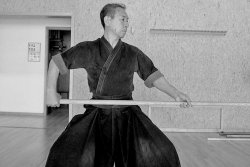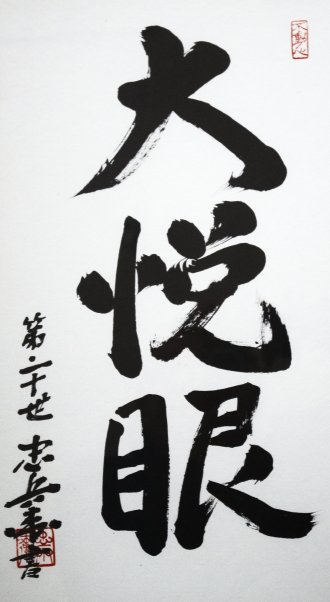Written by Kagita Chūbee, 20th sōke of the Hōzōinryū
The Techniques of the Hōzōinryū Sōjutsu
As I already wrote in the March issue one of the characteristics of the Hōzōinryū Sōjutsu is the use of a spear called Kamayari1 which has a blade in the form of a cross which sets it appart from the standard Suyari2. Thanks to its cross-shaped blade the Kamayari can not only be used for thrusting but in a lot of ways. One can beat down an opponent's spear in a cutting movement3 or in a rotating movement4 or slide5 along the shaft of the opponent's spear. The Hōzōinryū became Japan's largest spear style because the effectiveness of these techniques were recognized. In this issue I would like to deal with the techniques in more detail.
I always tell the disciples of our school to learn the spear with their body not their head. In my opinion mastery of the Sōjutsu techniques only takes place if they had become a part of one's flesh. For this reason I find it a little difficult to explain them using only words but I will try nonetheless.
 First of all there is the stance6. The left shoulder is facing the opponent, the feet are positioned approximately 1 meter appart. The right hand grasps the end of the spear shaft (Ishizuki)7, the left hand is placed approximately 1 meter away from the right hand, so the spear comes into a horizontal position. The hip is lowered into a position resembling Shiko8 in Sumō. The back is upright. The face faces the opponent frontally. To achieve this the head ist turned 90 degrees to the left until the chin comes to rest above the left shoulder. Beginners find this stance extremely uncomfortable and especially painful for the legs. But once one gets used to it, one recognizes that this is the optimal stance for handling a long and heavy spear.
First of all there is the stance6. The left shoulder is facing the opponent, the feet are positioned approximately 1 meter appart. The right hand grasps the end of the spear shaft (Ishizuki)7, the left hand is placed approximately 1 meter away from the right hand, so the spear comes into a horizontal position. The hip is lowered into a position resembling Shiko8 in Sumō. The back is upright. The face faces the opponent frontally. To achieve this the head ist turned 90 degrees to the left until the chin comes to rest above the left shoulder. Beginners find this stance extremely uncomfortable and especially painful for the legs. But once one gets used to it, one recognizes that this is the optimal stance for handling a long and heavy spear.
Next comes the footwork. There we have Okuriashi and Ayumiashi.
To advance in Okuriiashi the left foot ist pushed forward towards the opponent, immediately followed by the right foot which also moves forward 10 cm. To retreat in Tsugiashi the order of the movements is reversed.
To advance in Ayumiashi the right foot is placed in front of the toes of the left foot which then is moved forward approximately 1 meter. To retreat the left foot is placed behind the heel of the right foot which then is moved backward approximately 1 meter. It is very important that the hip neither bounces up and down nor moves left and right.
Then there is Hikiotoshi9. In this technique the Suyari that comes thrusting to the Maemen10 is beaten down with the right sickle of the Kamayari. This technique is only possible with a Kamayari. The opponents spear is not pressed down with the sickle. Instead it is beaten down with a pull like one would use to cut its shaft.
In Makiotoshi11 the Kamayari parries a thrust to his Uramen (the region around the left ear) by raising both hands. This block is called Kanmuriuke12 because it somewhat looks like crowning oneself with the spear. After having thus parried the Suyari it is beaten down in a twisting or enwrapping movement using the part of the Kamayari where the sickle crosses the shaft. This technique as well is only possible with a Kamayari.
In Surikomi13 the Kamayari uses the richt sickle to slide along the Suyari's shaft toward the opponents left hand when the Suyari thrusts to cut his wrist. There are also techniques where the left sickle is used for the same purpose.
In Egaeshi14 the Kamayari uses the momentum created when the Suyari tries to hurl the Kamayari upwards to jump towards his opponent while reversing his spear to finally apply a thrust to the opponents throat with the Ishizuki of the Suyari.
One more characteristic of Hōzōinryū Sōjutsu is the fact that there are only a few techniques which wound an opponent mortally or deal him the coup de grace. Techniques which only stop an attack and kill only the opponent's aggressiveness but take to wounding him only a a last resort on the other hand are numerous. In my opinion the Hōzōinryū spear-fencing therefore is a peaceful martial art.
 As innermost and most important core of Hōzōinryū Sōjutsu the precept of Daietsugen15 has been handed down. Whether in a real confrontaion or in everyday training one shouldn't stare at one's opponent grimly but but strive for Daietsugen or in other words a smiling glance. The idea behind this is the fact that by taking away the strength from the glance the shoulders will relax as well and the body will assume a natural position automatically. Thus body and spirit will open up and become free. This concept applies not only to Hōzōinryū Sōjutsu but ist true for all martial arts and even proves helpful for living in nowadays society.
As innermost and most important core of Hōzōinryū Sōjutsu the precept of Daietsugen15 has been handed down. Whether in a real confrontaion or in everyday training one shouldn't stare at one's opponent grimly but but strive for Daietsugen or in other words a smiling glance. The idea behind this is the fact that by taking away the strength from the glance the shoulders will relax as well and the body will assume a natural position automatically. Thus body and spirit will open up and become free. This concept applies not only to Hōzōinryū Sōjutsu but ist true for all martial arts and even proves helpful for living in nowadays society.
(First published in the Nara town magazine Ubusuna on October 5th 2009)
1. Sickle-spear.
2. Simple spear with a straight blade.
3. Kiriotoshi/Hikiotoshi.
4. Makiotoshi.
5. Surikomi.
6. Kamae.
7. In case of the Kamayari. In case of the Suyari the right hand grasps the spear approximately 30 cm away from the end of its shaft.
8. The ritual stomping before a bout.
9. Pulling down.
10. The face.
11. Beating down in a winding or twisting movement.
12. Crowning block.
13. Sliding in.
14. Reversed shaft.
15. Big eyes radiant with joy.
